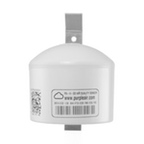Air Quality Frequently Asked Questions
What kind of air quality sensor does this site use?
What do PurpleAir sensors measure?
- PurpleAir sensors measure airborne particulate matter (PM). Particulate matter describes solid particles suspended in air including dust, smoke, and other organic and inorganic particles. PurpleAir sensors use laser particle counters to count the number of particles by particle sizes 0.3, 0.5, 1, 2.5, 5, and 10 μm, and uses the count data to calculate mass concentrations of PM1.0, PM2.5, and PM10.
How do PurpleAir sensors work?
- PurpleAir sensors use laser counters to measure particulate matter in real time. A laser counter uses a fan to draw a sample of air past a laser beam. Any particles in the air will reflect some light from the laser beam onto a detection plate, like dust shimmering in a sunbeam. The reflection is measured as a pulse by the detection plate and the length of the pulse determines the size of the particle and the number of pulses determines the particle count. The PM1.0, PM2.5, and PM10 mass concentrations are calculated from these particle counts.
How do PurpleAir sensors compare to regulatory particulate matter sensors?
- There are two major difference for PurpleAir sensors when being compared to regulatory sensors, (1) the method of measuring particulate matter and (2) the averaging time of the data collected.
Methods
- PurpleAir sensors use a laser particle counter to count the number of airborne particles in the air. That count is used to calculate a mass concentration, assuming an average particle density in an algorithm developed by the laser counter manufacturer, Plantower. They must use an average density because not all PM of a particular size is made of the same stuff. For instance, PM2.5 from wildfire smoke will have a different density than PM2.5 from dust blowing off a gravel pit. This means that mass concentration reported by a PurpleAir sensor can vary depending on the specific composition of PM for a given area thus making the sensors appear to "read high". So far, 2 different research groups have completed studies for their areas and created conversion factors specific to the composition of particulates in their air: AQandU and LRAPA.
Federal reference sensors typically measure mass concentration of PM by drawing air through a filter and weighing the filter. This method is expensive, difficult to install, requires a specialist to maintain the sensor, and reports on an hourly scale. Because of this many cities have a limited number of these sensors (or none at all) and it's not feasible for the general public have their own.
Averaging Time
- PurpleAir uses the AQI breakpoints established by the US EPA to convert the mass concentration into the AQI published on the PurpleAir map. However, the most regulatory groups report AQI as a 24-hour average that get updated every hour or so. If you look at PM on a website like AirNow, a PM2.5 AQI of 150 means the average AQI in the last 24-hours was 150.
PurpleAir sensors use laser particle counters to count the number of particles in sizes from 0.3um up to 10um. These get converted into a mass concentration (ug/m3) and reported every 120 seconds. Since air quality can fluctuate greatly throughout the day, the real time PurpleAir AQI reading may appear "high" when compared to 24-hour averaged AQI data.
If you want to compare 24-hour averaged AirNow data with 24-hour averaged PurpleAir data you can look at longer term averages on the PurpleAir map by selecting the averaging period from the options in the bottom left or by checking the "Show Rings (Averages)" in the Map Data Layer box in the lower left hand corner of the map.
Each ring represents the averages:
Center of the circle = Real time averages
1st ring = Short Term averages
2nd ring = 30 minute averages
3rd ring = 1 hour averages
4th ring = 6 hour averages
5th ring = 24 hour averages
6th ring = 1 week averages
EPA Particulate Matter Background Information
- Particulate matter contains microscopic solids or liquid droplets that are so small that they can be inhaled and cause serious health problems. Some particles less than 10 micrometers in diameter can get deep into your lungs and some may even get into your bloodstream. Of these, particles less than 2.5 micrometers in diameter, also known as fine particles or PM2.5, pose the greatest risk to health.
Particle Sizes and Effects
While they all look the same on a macroscopic level, the particles themselves come in different sizes. Some are smaller than a strand of hair, but most of the more volatile ones are much, much smaller. These size differences contribute to how each type of particle interacts and affects our health. For instance, our bodies can readily deal with most of the larger particles. We just cough or sneeze to get them out. Our throat and lungs act as a filter, therefore the larger particles cannot enter deeply in our bodies. However, there are particles out there for which we have no defenses against. These particles can either get trapped in our lung or make it through to our bloodstream.
The US EPA and researchers group the various particles in three broad categories.
The categories of airborne particulate include:
- Coarse particles (PM10) - These are the largest particle, such as wind-blown dust., ranging from 2.5 to 10 microns in aerodynamic diameter. Most of it is stopped by our lungs.
- Fine particles (PM2.5) - Most particles that can adversely affect our health fall under the fine category. These particles have diameters that are at least 2.5 microns or smaller. This includes stuff like smoke and haze.
- Ultrafine particles (PM1) - The smallest of the particles, these things have diameters that are smaller than 100 nanometers in size. Ultrafine particles can pass through any lung tissue right into the bloodstream. From there, they can circulate throughout your body along with your blood cells and oxygen. The exact effects of these PM1 on human health remain unknown, as there are much less studies about these.
However, because these particles can come from a number of sources, they often come with the different sizes mixed together. Some of them can even exist as liquids or liquid-suspended solids.
You will also find different types of particles floating in the air depending on where you live and the time of the year. For example, Sulfur dioxide and other sulfates are common in the Midwest, Southeast, and Northeast states. On the other hand, the Northeast, Southern California, the Northwest and North Central U.S often have high levels of nitrate and other organic particles during the winter.
Discussion of particulate matter (opens in a new tab/window)


